Oilpalm Insect Pests
Oilpalm Insect Pests
Spindle bug
Biology:- Egg: Eggs are laid singly between the leaflets of the spindle. The eggs hatch in 9 days.
- Nymph: There are five nymphal stages and it is completed in 15-24 days. The light violet brown nymphs have greenish yellow border.
- Adult: Adult bugs are brightly color red and black
- Spindle bug - generally noticed in nursery seedlings and plantation planted young seedlings.
- Adults and nymphs of spindle bug live in the innermost two to three leaf axils.
- Suck sap from the spindle of leaves
- Necrotic lesions which later on turn into dry brown patches.
- In severe infestation the spindle fails, to open.
Predators : Kingcrow, Ground beetles, Wasp, Spider
Root grub
Biology:- Egg: These beetles lay eggs in soil mostly up to 10 cm depth. Eggs hatch out in about three weeks.
- Larva: The grub period with three instars is completed within 7 to 8 months.
- Pupa: The pupation is in soil in cocoons of mud. This period lasts about one month.
- Adult: The adult beetle is chestnut brown in color.
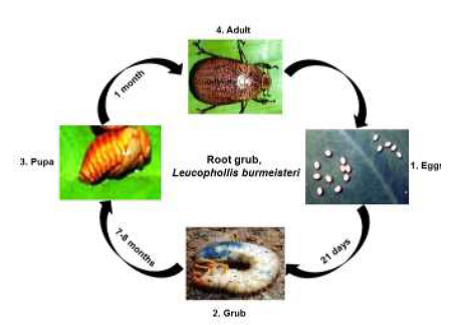
- Root grubs or „white‟ grubs occur mostly in sandy and sandy loam soils.
- They are voracious feeders on roots. Adult beetles emerge during May-June few days after receipt of pre-monsoon showers, between 6.30 to 7.30 PM.
- The early instar grubs feed on the roots of grasses and other humus. The second and third instar grubs of these beetles feed on tender and mature roots of the palm. In severe cases, the bole of the palm is also eaten up. They feed on roots of intercrops like banana, cocoa, tapioca, yams etc.
- In oilpalm seedlings, the feeding on roots results in dropping and drying of leaves
- Affected seedlings come off easily since the entire root system is usually eaten up. Palms with few years of infestation show a sickly appearance, with yellowing of leaves, tapering of stem, and reduction in yield.
- The palms may topple in case of severe loss of root system

- Parasitoids: Scoliids wasp
- Predators: False vampire bats, Garden lizards,Wild boar
Rhinoceros beetle
Biology:- Egg: O. rhinoceros eggs are yellowish-white, measuring 3 mm in diameter and laid inside rotting vegetative matter. Initially oval in shape, they begin to swell about a week after laying and hatch within 11-13 days.
- Grubs/larvae: The larval stages are usually yellowish-white in color and may grow to about 60-100 mm long. Development of the larva takes 80-200 days: first instar takes 10-21 days, second instar takes 12- 21 days and third instar takes 60-125 days.
- Prepupae: The prepupa is somewhat similar in appearance to the larval stage, except that it is smaller than the final larval instar. Shrivelled in appearance, it shakes its body actively when disturbed.
- Pupae: Pupa is yellowish-brown in color and measures up to 50 mm in length. The pupal stage lasts 17- 30 days.
- Adults: Stout-looking adults, dark brown to black, shiny, 35-50 mm long and 20-23 mm wide, with a prominent horn on head. The males having a relatively longer horn than the female. The males can be differentiated more accurately by having a rounded shiny terminal abdominal segment while the female has a relatively hairier tail. Adults may live up to 6 months or more.
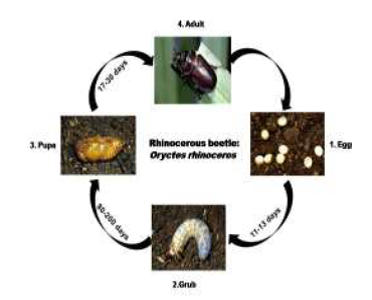
- O. rhinoceros adults feed in the crown region of both coconut and Oil palm.
- On oil palms they bore through petiole bases into the central unopened leaves. This causes tissue maceration and the presence of a fibrous frass inside the feeding hole is an indication of its activity within.
- Usually, a single attack is often followed by others on the same palm.
- These attacks subsequently produce fronds which have wedge-shaped gaps or the characteristic serrated cut (fan-shaped fronds)
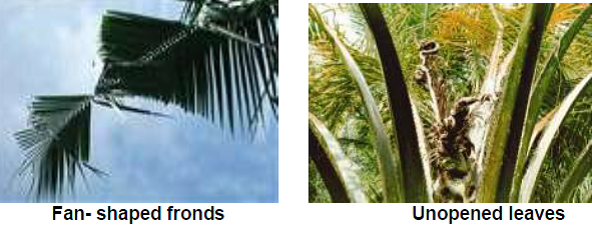
Predators: Tiger beetle , Squirrels, Barn owl
Red palm weevil
Biology:- Egg: Eggs are creamy white, oblong and shiny. The average size of an egg is 2.62 mm long and 1.12 mm wide. Eggs hatch in 3 days and increase in size before hatching.
- Grub/larva: The larvae can grow up to 35 mm long and can be recognised by the brown head and white body. The body is composed of 13 segments.
- Prepupa: The prepupal stage lasts for about 3 days.
- Pupa: pupal period varies from 12-20 days. Pupae are first cream colored but later turn brown. The surface is shiny, but greatly furrowed and reticulated. The average length of pupae is 35 mm and the average width is 15 mm.
- Adult: Adult weevils are reddish brown, about 35 mm long and 10 mm wide and are characterized by a long curved rostrum (snout). Dark spots are visible on the upper side of the middle part of the body. The head and rostrum comprise about one-third of the total length. In the male, the dorsal apical half of the snout is covered by a patch of short brownish hairs, the snout is bare in the female, more slender, curved and a little longer than the male. The longevity of the weevil ranges from 2-3 months, irrespective of the sex. In captivity, the maximum life span of the adult was 76 days for the female and 113 days for the male.
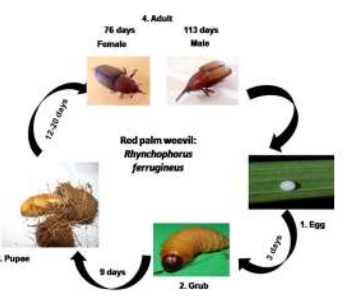
- It is very difficult to detect R. ferrugineus in the early stages of infestation. Generally, it is detected only after the palm has been severely damaged. Careful observation may reveal the following signs which are indicative of the presence of the pest
- Some holes in the crown or trunk from which chewed-up fibres are ejected. This may be accompanied by the oozing of brown viscous liquid
- Crunching noise produced by the feeding grubs can be heard when the ear is placed to the trunk of the palm
- A withered bud/crown.
- Chewed plant tissues in and around opening of tunnels with a typical fermented odor
- Fallen empty pupal cases and dead adults around a heavily infested palm
- Breaking of the trunk or toppling of the crown in case of severe and prolonged infestation.
- Drying of Offshoots in date palm

Predators: Dendrocitta vagabunda parvula
Caseworm
Biology:Pteroma pendula was the dominant bagworm species infesting oil palm Plantation. This species had six instar stages. Dimorphism was observed in pupa and imago stages. Female emerged as apterous and vermiform-like, and male emerged as moth. P. pendula had a lifespan of 50.4 ± 1.8 days.
Damage symptoms:- Holes on the leaves
- Occasional defoliation
- Cone shaped bags on the underside of leaves
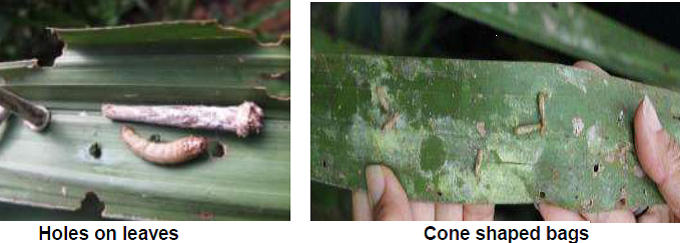
- Larval parasitoid: Pediobius anomalus
- Predator: Oecophylla smaragdina
IPM for Oilpalm
To know the IPM practices for Oilpalm, click here.
Source: NIPHM, Directorate of Plant Protection, Quarantine & Storage
Last Modified : 12/22/2021
This topic covers the information related to Insec...
This topic provides information about Oilpalm Pest...
This topic covers information about Arecanut Inse...
This topic provides information about Oilpalm Bene...
